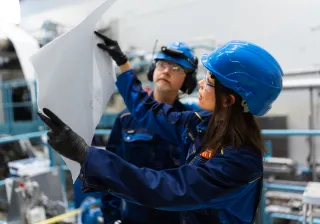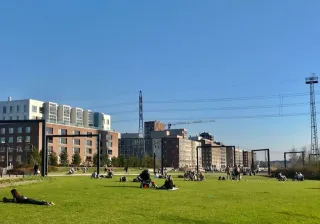Electrification of transport plays a key role in the green transition and in meeting emissions targets. The City of Jyväskylä used VTT Smart eFleet analysis service to determine whether electrification of public transport would be a viable option for the city. VTT's cost analysis based on virtual piloting showed that the city had every possibility to switch to electric buses.
Key results
VTT Smart eFleet analysis service supports the planning and organisation of low-carbon public transport. With VTT Smart eFleet, the piloting phase typically associated with the deployment of new technologies can be carried out fully virtually.
Jyväskylä obtained the data it needed for a successful tendering process.
From 2024 onwards, more than 60% of Jyväskylä's public transport will be operated by electric buses.
Jyväskylä, the seventh largest city in Finland, wants to be "Boldly ahead of its time". In its Linkki tulevaisuuteen 2030 public transport development programme, the city has set itself the goal of moving to zero-emission public transport by 2030.
Is electric public transport a feasible option for Jyväskylä?
In 2021, Jyväskylä was about to issue a tender for the procurement of public transport services. The city was taking steps towards clean public transport. Before announcing the tender, Jyväskylä wanted to find out under which technical and economic conditions electrification of public transport would be possible for them.
The officials in Jyväskylä recognised that the city's high-altitude differences affect the energy consumption of vehicles and could present a challenge for electrification. In addition, they wanted to find out whether the city's bus fleet, the number of passengers on routes, and the bus occupancy rates were suitable for electric mobility.
To build a better understanding within its organisation, Jyväskylä partnered with VTT.
"We wanted VTT's support in the decision-making process as we knew that they had successfully helped, for example, the Helsinki Region Transport (HSL) transition to emission-free transport," Kari Ström, Service Director of Urban planning and City infrastructure of Jyväskylä, describes the start of the cooperation.
VTT Smart eFleet analysis service for low-carbon transportation provides detailed information to support decision-making
VTT Smart eFleet analysis service has been developed to support decision-making, for example, in the public sector. It can be used to simulate and analyse different vehicles and infrastructure in their geographical environments, and to design a reliable and cost-effective low-carbon public transport system.
The Smart eFleet analysis in Jyväskylä's assignment began with the collection of the initial data needed for the simulation. The initial data comprised existing vehicle duty cycles, passenger volumes, timetables, and local energy prices, among other things.
"With the help of Jyväskylä's skilled traffic planning team, we were able to put together the initial data quickly," says Rafael Åman, Research Team Leader at VTT. "We also used public mapping services to retrieve terrain data and used it to model the bus routes. The data collected formed the basis for our simulation and analysis."
To support Jyväskylä’s tendering process for public transport services, three clean energy carrier options were studied: biodiesel, biomethane and electricity. The focus of the study was on costs, which included the initial investment costs as well as infrastructure, energy and labour costs.
VTT selected three different types of electric buses for the study. The VTT Smart eFleet tool was used to simulate several different options for electrification: various bus sizes and battery capacities with both depot charging and high-power charging options. Jyväskylä was also concerned about the emissions from auxiliary diesel heaters used in electric buses and their impact on air quality at the bus stops in the city centre. Thus, an estimate was made of the type of fleet that could operate on electricity alone, even in sub-zero temperatures.
Jyväskylä trusted our expertise on the matter. We have gathered an extensive vehicle database that contains comprehensive data on buses.
VTT studied also the bus routing. The aim was to find out at which passenger load levels and on which lines the different options would work the best.
The simulation results showed that the most economical options for Jyväskylä were a biomethane driven bus and an electric bus with depot charging. The simulation also showed that the electric bus with depot charging was the best option on less frequented, shorter routes.
Further studies ensure there is no room for second-guessing
After two review rounds, Jyväskylä decided to commission further studies from VTT to ensure that even the last remaining questions were answered.
"We wanted to further strengthen our overall understanding of what electric transport means for us," says Ström.
The additional assignment meant simulating a few new routes. "With this additional assignment, the question of whether electricity was a viable option was no longer a concern. The simulation showed that by choosing a shorter route with lower passenger load levels, electricity becomes a competitive option," says VTT's Åman.
"It was great to see Jyväskylä's strong commitment to low-emission transport. This was reflected in the way all options were considered thoroughly, leaving no room for second-guessing. It was a pleasure to be able to help Jyväskylä on this journey."
Successful tendering and the second highest number of low-emission buses in Finland
The simulations provided Jyväskylä with the information it needed to launch its tendering process. Ström is very satisfied with the results of the cooperation.
"Virtual piloting was the only right solution for us. It allowed us to get the information we needed quickly and cost-effectively."
The cooperation with VTT was seamless and straightforward throughout the project. Information flowed back and forth.
"Based on the results obtained, we defined the quality score of the energy carrier in our tender. The quality scores for electricity and biomethane were the same. However, for the contract period starting in June 2024, the winning operator is going to use significantly more electric buses than we required," Ström says.
"With that, Jyväskylä's public transport will have the second highest number of low- or zero-emission buses in Finland when the number of electric buses is compared to the total fleet."
VTT also praises the fruitful cooperation.
"With VTT Smart eFleet, we want to make a substantial impact on society. Our ambition is to reduce emissions and contribute to a healthier planet. Jyväskylä’s assignment was therefore a perfect fit for us," sums up VTT's Åman.









